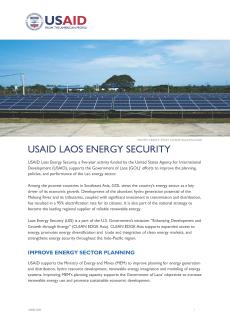USAID Laos Energy Security, a five-year activity funded by the United States Agency for International Development (USAID), supports the Government of Laos (GOL)’ efforts to improve the planning, policies, and performance of the Lao energy sector.
Among the poorest countries in Southeast Asia, GOL views the country’s energy sector as a key driver of its economic growth. Development of the abundant hydro generation potential of the Mekong River and its tributaries, coupled with significant investment in transmission and distribution, has resulted in a 95% electrification rate for its citizens. It is also part of the national strategy to become the leading regional supplier of reliable renewable energy.
Laos Energy Security (LES) is a part of the U.S. Government’s initiative: “Enhancing Development and Growth through Energy” (CLEAN EDGE Asia). CLEAN EDGE Asia supports expanded access to energy, promotes energy diversification and trade and integration of clean energy markets, and strengthens energy security throughout the Indo-Pacific region.
IMPROVE ENERGY SECTOR PLANNING
USAID supports the Ministry of Energy and Mines (MEM) to improve planning for energy generation and distribution, hydro resource development, renewable energy integration and modeling of energy systems. Improving MEM’s planning capacity supports the Government of Laos’ objectives to increase renewable energy use and promote sustainable economic development.
STRENGTHEN THE POLICY, LEGAL, AND REGULATORY FRAMEWORK OF THE ENERGY SECTOR
USAID engages MEM to strengthen its power sector policy and regulatory capacity. LES is supporting MEM’s development and implementation of a clear legal, institutional, and regulatory framework that will promote responsible and sustainable energy sector development. The tools and capacity developed by USAID will help Laos enforce its energy-related policies, laws, and regulations and promote private investment.
IMPROVE PERFORMANCE OF STATE-OWNED UTILITY
USAID partners with Électricité du Lao (EdL) – the state-owned enterprise controlling and managing electricity distribution in Laos – to improve their technical and financial operations through development of monitoring tools and capacity building. USAID is helping to identify and mitigate the contractual and operational challenges they face in order to increase their financial viability.
KEY RESULTS
- Increased capacity of MEM and EdL staff in a wide range of areas, including, power system planning, reservoir management, site inspections of substations and transmission lines, distribution system reliability, demand forecasting, renewable energy development and integration, and enabling environment for advanced technology (e.g., solar, wind, energy storage, electric vehicles).
- The Activity supported Laos’ EV adoption policy through various means, including facilitating public-private dialogue for EV Charging Station Business Management Regulation, developing a recommendation report to support drafting the national EV roadmap, and fostering knowledge exchange on regional EV developments. Additionally, ongoing support is provided to build capacity on various topics, including EV battery technology, charging infrastructure, and safety requirements.
- The Activity is in the process of mobilizing over $1 million of investment for clean energy under the USAID Clean Energy Innovation Fund (CEIF). USAID provided matching grants (up to $250,000 per grant) to renewable energy entrepreneurs in Laos to test innovative applications of renewable energy technologies and leverage private sector investment. During the comprehensive grantmaking co-creation process, local entrepreneurs expanded valuable proposal design and development skills that will aid them in future resource mobilization efforts. By providing matching grants to local businesses, to promote clean energy, protect the environment, and reduce carbon emission.
- The project will enable the development of at least 100 kW of solar generation capacity by collaborating with the private sectors and NGOs to promote solar energy across diverse sectors. This includes implementing solar-powered irrigation systems for agriculture production and installing solar technology to reduce upfront cost to connect to the grid, reducing electricity cost in the medium term. Such initiatives drive the application of clean energy, aiding adaptation efforts across different domains.
- Obtained projected greenhouse gas (GHG) emissions reductions of 300,000 tCO2e equivalent until 2040. Achieving this involves incentivizing clean energy in off-grid areas, curbing reliance on gasoline generators to enhance local air quality, and bolstering EV infrastructure to accommodate 30% EV adoption by 2030. This supports the implementation of Nationally Determined Contribution to achieve emissions reduction in clean energy and sustainable transport.
- Enhanced workforce development in the energy sector through professional development programs at MEM and EdL such as English language, and specific technical skills while also supporting national energy forums, training, and quarterly roundtable meetings with women in energy.


